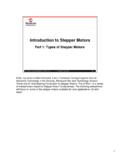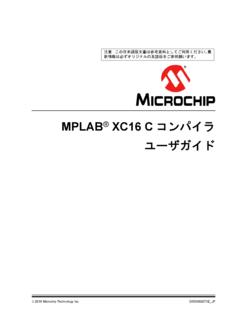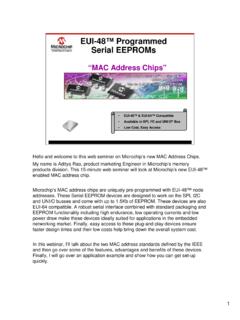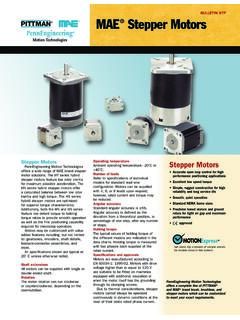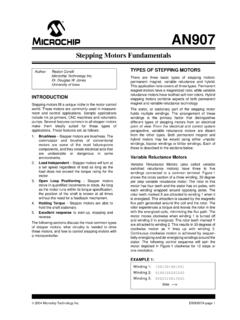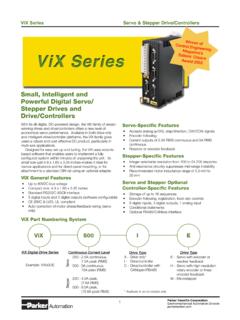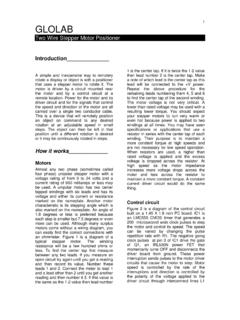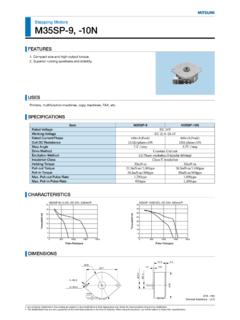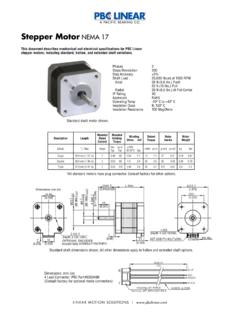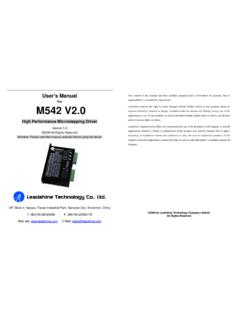Transcription of Introduction to Stepper Motors - Microchip …
1 1 2007 Microchip technology Incorporated. All Rights Reserved. WebSeminar Title Slide 1 Introduction to Stepper MotorsPart 2: Stepper motor ControlMy name is Marc McComb, I am a Technical Training Engineer here in Microchip s Security, Microcontroller and technology Division. Welcome to Part 2 in the Introduction to Stepper Motors series of Web Seminars, Stepper motor Control 2 2007 Microchip technology Incorporated. All Rights Reserved. WebSeminar Title Slide 2 AgendazIn this WebSeminar we will discuss: Different algorithms to step the motor Anti-resonance and its implications Drive Circuits In the following webseminar we will expand on Part 1 by discussing different stepping algorithms to improve step resolutions.
2 We will also discuss anti-resonance and how to deal with it. Finally, we will look at some basic circuitry to interface a Stepper motor to a 2007 Microchip technology Incorporated. All Rights Reserved. WebSeminar Title Slide 3 Stepping the MotorzDifferent step modes produce different step anglesFull StepHalf StepMicrostepAs we saw in Part 1, each Stepper motor will have a defined step angle associated with it. In the above example we can see that with 2 phases, we have a step angle of 90 degrees. If we implement some basic techniques we can improve the resolution of the motor by decreasing the stepping angle. 4 2007 Microchip technology Incorporated.
3 All Rights Reserved. WebSeminar Title Slide 4 Bipolar Full Step ControlNSPORTBW inding AWinding BB 0B0 Winding B0A 0 AWinding A4321 StepABA B Used in motor DriveMotorDrivePIC MicrocontrollerRB2RB3RB4RB5RB0RB1RB6RB7 First, let s discuss full stepping. Here the rotor is rotated at its specified step angle resolution. In the above diagram, two windings are connected to a motor drive circuit which we will specify as a black box at this point. Later in this presentation we will look inside this black box. For now though we will concentrate on the motor windings and the PIC Microcontroller. Notice that we are using a simple General Purpose Input/Output Port peripheral here PORTB as an example.
4 We will focus our attention to the top 4 Most Significant Bits in PORTB for the time being as the Lower 4-bits are used in the motor Drive Black Box Circuit. We will use the nomenclature throughout this presentation by defining each lead of each winding as follows: Winding A leads will be identified by leads A and A , while winding B leads will be identified by leads B and B . At the top Left-Hand corner of the diagram is our stepping algorithm. Let s step through this 2007 Microchip technology Incorporated. All Rights Reserved. WebSeminar Title Slide 50001 Bipolar Full Step ControlNS0001 PORTBW inding AWinding AWinding BNScurrentB 0B0 Winding B0A 0 AWinding A4321 StepABA B MotorDrivePIC MicrocontrollerRB2RB3RB4RB5RB0RB1RB6RB7 The first step applies a positive voltage or logic HIGH to Winding A s lead A while driving lead A LOW.
5 Current is generated in the direction shown creating a magnetic flux polarizing the stator poles accordingly. The rotor rotates to minimize the magnetic flux flow 2007 Microchip technology Incorporated. All Rights Reserved. WebSeminar Title Slide 60010 Bipolar Full Step ControlNS0010 PORTBW inding AWinding BWinding BNScurrentNSB 0B0 Winding B0A 0 AWinding A4321 StepABA B MotorDrivePIC MicrocontrollerRB2RB3RB4RB5RB0RB1RB6RB7 The next step removes the applied voltage to Winding A and drives lead B HIGH initiating current flow towards lead B which is driven LOW. Again the rotor rotates minimizing the reluctance. Notice that as we step through this full step algorithm we are simply shifting a set bit right each time.
6 Remember though, you will need to connect the motor lead to the appropriate pins to accommodate this 2007 Microchip technology Incorporated. All Rights Reserved. WebSeminar Title Slide 70100 Bipolar Full Step ControlNS0100 PORTBW inding AWinding AWinding BNScurrentNSNSB 0B0 Winding B0A 0 AWinding A4321 StepABA B MotorDrivePIC MicrocontrollerRB2RB3RB4RB5RB0RB1RB6RB7 Continuing through the algorithm, lead A is next driven HIGH 8 2007 Microchip technology Incorporated. All Rights Reserved. WebSeminar Title Slide 81000 Bipolar Full Step ControlNS1000 PORTBW inding AWinding BcurrentB 0B0 Winding B0A 0 AWinding A4321 StepABA B MotorDrivePIC MicrocontrollerRB2RB3RB4RB5RB0RB1RB6RB7 Followed finally by driving lead B HIGH to complete the 360 degree 2007 Microchip technology Incorporated.
7 All Rights Reserved. WebSeminar Title Slide 9 Full Step One Phase On Voltage SequencezTermed Wave Drive or One Phase On ControlABSTEP 1 STEP 2 STEP 3 STEP 4 STEP 1A B This type of full step algorithm is referred to as One Phase On Voltage sequence. The term Wave Drive is sometimes used as the voltage sequence resembles a wave. Each lead is energized one at time for each 2007 Microchip technology Incorporated. All Rights Reserved. WebSeminar Title Slide 10 Determining SpeedzNumber of Steps per Revolution= 360 /Angle for one stepExample360 /90 = 4 steps/revolutionzNumber of Pulses Per Second (PPS)=[ (Desired RPM) / 60 seconds] x Number of Steps/revolutionExample[(120 RPM)/60 seconds] x (4 steps/revolution) = 8 pulses/secondLet s take a moment and talk about speed of revolution or RPM.
8 We can determine how fast to apply the individual steps by following a few simple equations. First we need to determine how many steps actually make up a complete 360 degree revolution. In this case, since we have a 90 degree step angle for each individual step, we can say that it will take four steps for a complete revolution. Next, we need to know how many pulses or steps we will apply per second to achieve the desired revolution. Therefore, we divide our desired RPM by 60 seconds and then multiply the quotient by the number of steps in a complete revolution. The product provides us with the number of steps required per second to obtain the desired 2007 Microchip technology Incorporated.
9 All Rights Reserved. WebSeminar Title Slide 11 TimingzTimer0 to time PPS Pulse applied each time TMR0 interrupt occurs Must load TMR0 with a predetermined valueNSWinding AWinding BABA B Timer0 MotorDrivePIC MicrocontrollerRB2RB3RB4RB5RB0RB1RB6RB7W e can easily implement the steps per second using Timer0 interrupts. We must first configure the Timer0 prescaler accordingly and then load a pre-calculated value into the TMR0 register that will interrupt the CPU at the appropriate time intervals to perform subsequent 2007 Microchip technology Incorporated. All Rights Reserved. WebSeminar Title Slide 12 Full Step One Phase On AlgorithmIncrement counter variablecounter = 4?
10 Output step (counter) to PORTB TMR0 InterruptInitialize Peripherals Set PORTB direction Initialize PORTB Enable TMR0 interrupts load TMR0 value Create 8-bit variable counter= 0 Define step values: STEP_ONE = 1000xxxx STEP_TWO = 0100xxxx STEP_THREE = 0010xxxx STEP_FOUR = 0001xxxxLoopMain routinereturnYESC lear counterNOReferring to the above flow chart, to implement this in software, we must first initialize the two peripherals PORTB and Timer0 as discussed. We must also define values to pass to the PORTB register that will produce the desired output sequence as well as define a counter variable. Following peripheral initialization and variable definitions, we simply place the CPU into a loop.
